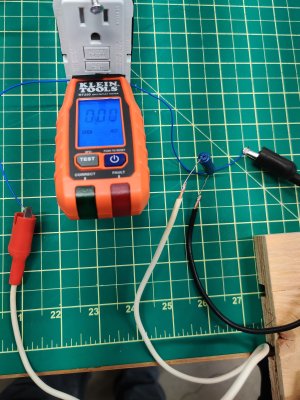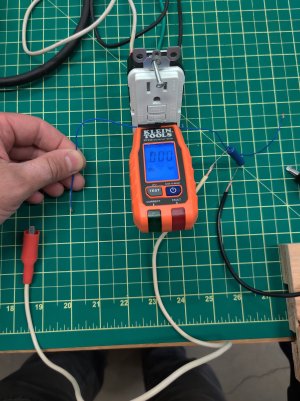Elektrishun
Ultra Member
I know there are some smart electronics people here. Thought I would see if anyone would like to try and hazard a guess as to what is going on with this Klein Tools RT250 GFCI tester.
To help show what is going on I made a Youtube video (see link below).
Keep in mind 4 things:
(1) I am testing a brand new GFCI but I got the same results on installed GFCI receptacles in my house (yet some GFCI receptacles in my house and outdoors tested "good")
(2) Display showing "000" and "OPEN HOT" indicates GFCI is working
(3) Display showing "OPEN GRD NEU" and "> 30V" is obviously a fault but is clearly false (proven false with further testing using DMM)
(4) I already replaced 1 GFCI receptacle that gave me the "OPEN GRD NEU" and "> 30V" result. New GFCI receptacle installed in same location when tested showed "000" and "OPEN HOT"
Youtube video of RT250 testing
Is it the test device that is wonky, or the GFCI that is fuzzing the results, or maybe even user error?
I read the manual.🙂
It does state:
NOTE: All appliances or equipment on the circuit being tested should be unplugged to help reduce the possibility of erroneous readings.
I usually interpret "circuit" to mean right back to the panel but that seems kinda silly for a GFCI test.
NO, I DO NOT TRUST THIS DEVICE and will likely return it. Nonetheless, I can't help but be curious as to what is happening with this tester.
To help show what is going on I made a Youtube video (see link below).
Keep in mind 4 things:
(1) I am testing a brand new GFCI but I got the same results on installed GFCI receptacles in my house (yet some GFCI receptacles in my house and outdoors tested "good")
(2) Display showing "000" and "OPEN HOT" indicates GFCI is working
(3) Display showing "OPEN GRD NEU" and "> 30V" is obviously a fault but is clearly false (proven false with further testing using DMM)
(4) I already replaced 1 GFCI receptacle that gave me the "OPEN GRD NEU" and "> 30V" result. New GFCI receptacle installed in same location when tested showed "000" and "OPEN HOT"
Youtube video of RT250 testing
Is it the test device that is wonky, or the GFCI that is fuzzing the results, or maybe even user error?
I read the manual.🙂
It does state:
NOTE: All appliances or equipment on the circuit being tested should be unplugged to help reduce the possibility of erroneous readings.
I usually interpret "circuit" to mean right back to the panel but that seems kinda silly for a GFCI test.
NO, I DO NOT TRUST THIS DEVICE and will likely return it. Nonetheless, I can't help but be curious as to what is happening with this tester.



